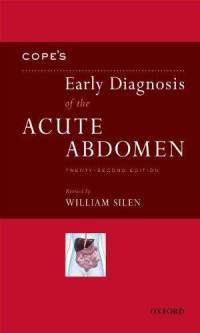“You cannot be a real general surgeon without reading this book.”– Schein (p. 27)
Cope’s Early Diagnosis of the Acute Abdomen is one of the most famous, if not the most famous, single subject book in all of medicine. Now in its twenty-second edition, it remains an excellent monograph about the history and physical examination of patients with abdominal complaints. The book is replete with hundred, if not thousands, of clinical pearls.
Some of these pearls are relatively straightforward. For example, “Any patient with an arrhythmia such as auricular fibrillation who complains of abdominal pain should be highly suspected of having embolization to the superior mesenteric artery until proven otherwise” (p. 198). Others are pretty advanced, sophisticated and sometimes even clever. For example, Dr. William Silen writes that a ruptured abdominal aortic aneurism into the inferior vena cava should be suspected in a patient with a sudden onset of severe heart failure that does not respond to usual interventions. If this happens, one should look for an abdominal murmur, and consider imaging the vasculature of the abdomen (p. 204-205). There are hundreds upon hundreds of gems like these throughout the book.

The book is excellent in its approach to the surgical abdomen. Some of the non-surgical aspects of the book, however, need to be interpreted and applied with caution. For example, the author states that the first step in the laboratory evaluation of a patient with suspected “impending coma in diabetes” is “the routine examination of the urine for sugar. If sugar is found, the presence or absence of ketones must be determined. If ketosis is found … immediate steps should be taken to treat the ketosis by administration of insulin with glucose” (p. 272).
This approach to diabetic ketoacidosis (DKA) is potentially dangerous for at least four reasons:
- First, examination of the urine for glucose is a relatively insensitive test for hyperglycemia. Similarly, calculating the anion gap is a far better screening test for ketoacidosis than urinalysis. “Negative urine anion dipstick test for ketones does not rule out diabetic Ketoacidosis (serum ketones should also be measured).” Desai (2009).
- Second, there is no mention of the invariable need for volume resuscitation. Patients with DKA have a fluid deficit of approximately 6 liters. Volume resuscitation is obviously of paramount importance.
- Third, glucose should not be given indiscriminately to patients with DKA. There may be a role for the administration of dextrose in patients with DKA, but that is only after serum glucose is determined to be low enough. Administering glucose to patients who don’t need it will only exacerbate or delay the resolution of hyperglycemia, volume depletion, and kidney injury.
- Fourth, as Dr. Hoffman likes to point out in his Emergency Medical Abstracts, one should avoid administering insulin to a patient with DKA without first “knowing the K” (potassium). Otherwise, the patient might develop dangerous complications from hypokalemia.
Overall, the book is a smart, nuanced, interesting and sometimes even entertaining approach the early diagnosis of the surgical abdomen. It establishes a very useful framework for understanding and remembering all of the common, and most of the rare, causes of abdominal complaints. As such, I recommend Cope’s Early Diagnosis of the Acute Abdomen very highly as a surgery book to anyone interested in primary care or surgery. It is one of the best medical books of all time.
You can sample the book free of charge here.
References
- Desai, Samir P., MD, Clinician’s Guide to Laboratory Medicine: Pocket (2009, reviewed here)
- Moshe Schein MD, Schein’s Common Sense Emergency Abdominal Surgery: An Unconventional Book for Trainees and Thinking Surgeons
- Pocket Medicine, 5e (2013).


Leave a Reply